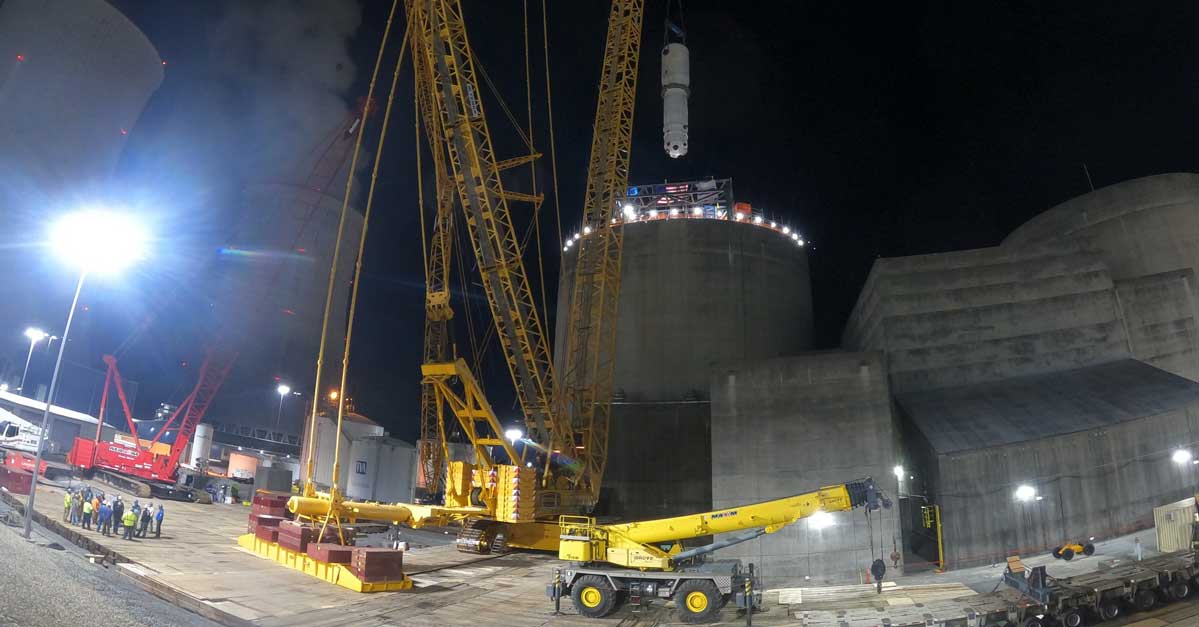From left: Romanian minister of energy Virgil Popescu, U.S. Export-Import Bank president and chair Reta Jo Lewis, Romanian president Klaus Iohannis, U.S. special presidential envoy for climate John Kerry, and U.S. State Department assistant secretary Geoffrey Pyatt. (Photo: ExIm)
The Export-Import Bank of the United States has issued two letters of interest (LOIs) for the financing of U.S.-sourced pre-project technical services in connection with the proposed reactor construction project at Romania’s Cernavoda nuclear plant, the bank announced last week.
Centrifuge casings arrive in Piketon, Ohio. (Photo: Centrus Energy)
The Department of Energy announced a cost-shared award on November 10 valued at about $150 million for American Centrifuge Operating, a subsidiary of Centrus Energy, to complete the high-assay low-enriched uranium (HALEU) demonstration project it began in 2019. After delays that Centrus attributes in part to the COVID-19 pandemic, the company now has until the end of 2023 to produce the first 20 kilograms of HALEU enriched to 19.75 percent U-235 from the 16-centrifuge cascade it has installed in a DOE-owned Piketon, Ohio, facility—the only U.S. facility currently licensed to produce HALEU.
Crews completed the teardown of Oak Ridge’s Bulk Shielding Reactor (Building 3010), once used for research as part of the federal Aircraft Nuclear Propulsion Program. (Photos: DOE)
The Department of Energy’s Office of Environmental Management (EM) said its cleanup contractor UCOR recently completed the first-ever demolition of a reactor in the central campus area at the Oak Ridge National Laboratory in Tennessee.
Demolition and disposal shifted into high gear this spring at the DOE’s former uranium enrichment plant in Ohio.
In the 1950s, the U.S. Department of Energy constructed the Portsmouth Gaseous Diffusion Plant in rural southern Ohio to enrich uranium, alongside two other federally owned and managed facilities in Oak Ridge, Tenn., and Paducah, Ky. The Cold War-era plant was built as a self-sufficient industrial city with more than 400 buildings and facilities centered around three massive gaseous diffusion process buildings that could enrich the level of the uranium-235 isotope for nuclear fuel in the defense and energy sectors.
A steam generator is lifted into Watts Bar Unit 2. (Photo: Framatome)
The Steam Generating Team (SGT)—a joint venture of Framatome and United Engineers & Constructors Inc.—has completed a project to replace the Unit 2 steam generators at the Watts Bar nuclear plant, Framatome announced last week.
Watts Barr’s owner and operator, the Tennessee Valley Authority, awarded Framatome the contract for the work in early 2020.
Scheduled to appear at the Energy Security panel session at COP27: from left, moderator Sweta Chakraborty and speakers Kathryn Huff, Seth Grae, and Bonnie Jenkins.
The United Nations’ COP27 conference, held this year in Sharm el-Sheikh, Egypt, from November 6 to 18, will feature the panel discussion “Energy Security” on Tuesday, November 15, at 9:00 a.m. EST (4:00 p.m. local time). The discussion is being sponsored by the review platform We Don’t Have Time; the live stream will be available to viewers on their COP27 Climate Hub website.
Research engineers take a sample of molten salt for the NEXT Lab. (Photo: Jeremy Enlow/Steelshutter)
The Nuclear Energy eXperimental Testing (NEXT) Laboratory at Abilene Christian University in Texas created quite a bit of buzz within the nuclear community in August when it submitted the first application for a new U.S. research reactor in more than 30 years. The construction permit application submitted to the Nuclear Regulatory Commission is for a molten salt research reactor (MSRR)—the first-ever university application for an advanced research reactor. Assuming NRC acceptance of the application, which could happen this year, a formal technical review of the lab’s MSRR plan will then begin, and construction of the MSRR could be completed by 2025. The Abilene campus’s new Science and Engineering Research Center—a 28,000-square-foot multiuse facility for chemistry, physics, and engineering research and education—is expected to be completed by July 2023 and will house the advanced reactor. The final step is to obtain the NRC operating license for the MSRR and commence operation.
The opening session of ICGR-6. (Photo: OECD NEA)
While deep geological repositories (DGRs) are the globally preferred and scientifically proven solution to store high-level radioactive waste, societal challenges remain. Given the long time frames associated with DGR development and implementation, and a rise in global interest in nuclear energy to meet urgent climate mitigation targets, building and maintaining human capacity is now even more of a priority.
On the left, equipment being installed at Indian Point-3 on April 26, 1971. Unit 3 began operation in August 1976. On the right, some of the same equipment being removed as part of the decommissioning process, November 2022. (Photo: Indian Point Energy Center)
Holtec continues the decommissioning work at Indian Point nuclear power plant in Buchanan, N.Y.
Unit 2, a 1,028-MWe pressurized water reactor, was shut down in April 2020; Unit 3, a 1,041-MWe PWR, was closed one year later. (Unit 1 was decommissioned in 1974.)
The U.S. ITER Project Office in Oak Ridge, Tenn. U.S. ITER has received $256 million in Inflation Reduction Act funding. (Photo: U.S. ITER)
Just days before COP27 and the U.S. midterm elections, the White House announced $1.55 billion in Inflation Reduction Act (IRA) funding for national laboratories and the launch of a Net-Zero Game Changers Initiative based on a new report, U.S. Innovation to Meet 2050 Climate Goals. Out of 37 research and development opportunities identified, fusion energy was selected as one of just five near-term priorities for the new cross-agency initiative. Together, the announcements signal policy and infrastructure support for fusion energy—the biggest chunk of Department of Energy Office of Science (DOE-SC) IRA funding went to ITER, via Oak Ridge National Laboratory—and for advanced nuclear technologies to power the grid and provide process heat to hard-to-decarbonize industrial sectors.
ANS's “Powering Our Future: The Coal to Nuclear Opportunity” panel discussion featured (top left, clockwise) Jessica Lovering, Patrick Burke, Kenya Stump, Andrew Griffith, Christine King, and Carol Lane. (ANS screenshot)
Since at least June of last year—when TerraPower and PacifiCorp announced plans to site the Natrium reactor demonstration project at one of Wyoming’s retiring coal plants—the concept of repurposing those plants to host nuclear reactors has been a popular topic of conversation among the energy cognoscenti.

















